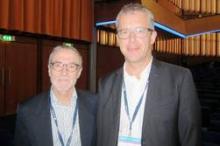AMSTERDAM – Despite persistent stigma, electroconvulsive therapy endures as an effective treatment for depression, particularly when applied with a patient-specific approach, according to several study results presented at the annual congress of the European College of Neuropsychopharmacology.
Dr. Charles Kellner, professor of psychiatry at the Icahn School of Medicine at Mount Sinai, New York, said ECT is well established as effective in elderly populations with depression and is notable for its ability to rapidly curb suicidal ideation, as shown by unpublished data from his PRIDE study (Prolonging Remission in Depressed Elderly, NCT01028508). That study showed an 85% drop in suicidality in patients by the end of their ECT treatment course.
“ECT would be one of the very best treatments in all of medicine” if not for several factors, Dr. Kellner said. ECT cannot prevent relapse in depression unless it is used as maintenance therapy, and varying degrees of negative cognitive impact can come with the procedure, he said. In addition, ECT has been stigmatized by the popular media and others in the profession, and by the antipsychiatry movement, he said.
Despite all this, burgeoning data indicate clinicians have a variety of effective and efficacious ECT methods from which to choose. The overall calculus for which ECT method is best in a specific case “is severity of illness,” Dr. Kellner said in an interview. “It’s usually driven by suicidality and how dysfunctional the patient has become.”
In Dr. Kellner’s PRIDE phase I study, data indicated that 40% of 240 consenting patients with a mean age of 70 years and unipolar depression, given ultrabrief pulse right unilateral ECT three times weekly until remission, and augmented by a low dose of the selective serotonin reuptake inhibitor venlafaxine (up to 225 mg per day after any previous medication washout), were successfully treated for their depression after 1 week.
The response criteria was a 50% or greater reduction from baseline in at least 21 of 24 items on the Hamilton Rating Scale for Depression (HAM-D-24) after 1 week, while remission was defined as scoring 10 or less on the HAM-D-24 at two consecutive follow-up points each week. After two treatments, 8% of responders achieved remission, and nearly 18% remitted after a full week.
Meanwhile, patients who did not complete the study or meet the response and remission criteria still benefited, Dr. Kellner said. “Nonremitters [about 28% of the study] and dropouts [about 10%] get considerably better from whatever ECT they are able to have.”
ECT with a pulse width of less than 0.5 milliseconds is considered ultrabrief pulse ECT. Pulse widths of 0.5 msec or higher are considered standard ECT. Seizures induced by any pulse width are the theorized mechanism of action for reducing depression with ECT, but correlates between higher levels of energy and greater levels of negative cognitive effects are well established in the literature. Presenter Dr. Pascal Sienaert, a psychiatrist and director of the ECT program at the Catholic University of Leuven (Belgium), said that because the “ideal stimulus to depolarize a group of neurons would be 0.1 or 0.2 milliseconds,” ultrabrief pulse ECT should “theoretically” be the most effective with the least cognitive burden.
In the PRIDE study, nearly 85% of participants seized at the lowest stimulus dose during their first treatment when ultralow doses were used to determine each patient’s seizure threshold. Given the age of the cohort, this was a fortunate surprise, Dr. Kellner said, since it allowed subsequent dosing at six times the seizure threshold at low absolute stimulus charges. “This is a very efficient form of ECT for inducing a seizure,” Dr. Kellner said in his presentation.
About 10% of responders in the study experienced more than a 50% drop in their HAM-D scores after one treatment at the ultralow dose, which has created some debate over whether it was a placebo response. Dr. Kellner rejected this theory. “I think ECT is such a powerful biological treatment, it’s very hard to ascribe this to placebo.”
Rates of remission varied greatly in the PRIDE study, ranging from 20% remitting after 4 treatments, to 26% remitting after 10 treatments. “This speaks to the point that you can’t tell a patient how long their treatment will be. Some need fewer treatments; some need prolonged courses.”
But Dr. Sienaert’s own findings cast doubt on the ability of ultrabrief pulse ECT to ensure fewer cognitive burdens than standard ECT.
In a randomized comparison of ultrabrief bifrontal and unilateral ECT for patients with refractory depression, no significant differences were found in response and remission rates. However, the cohort treated with right unilateral ultrabrief pulse ECT required fewer treatments to reach response and remission (J Affect Disord. 2010 Apr;122[1-2]:60-7. doi: 10.1016/j.jad.2009.06.011).


